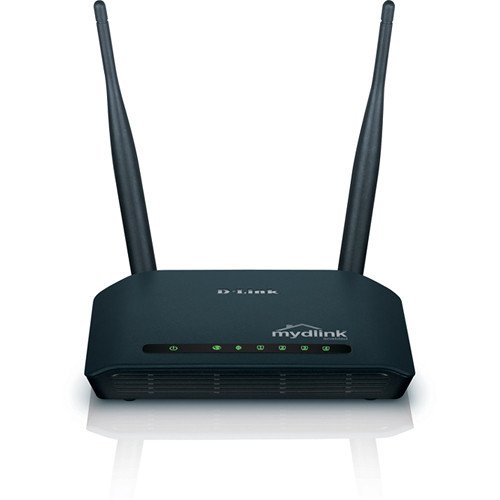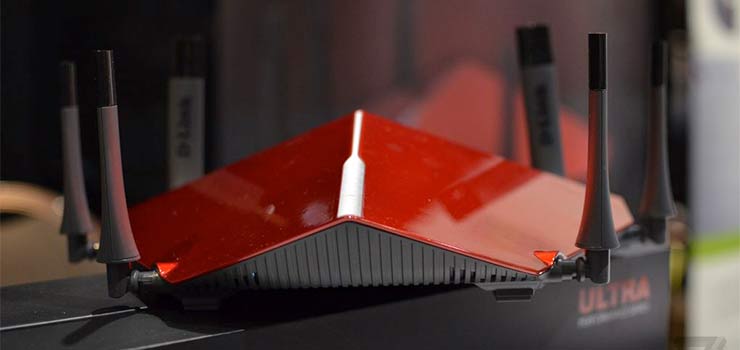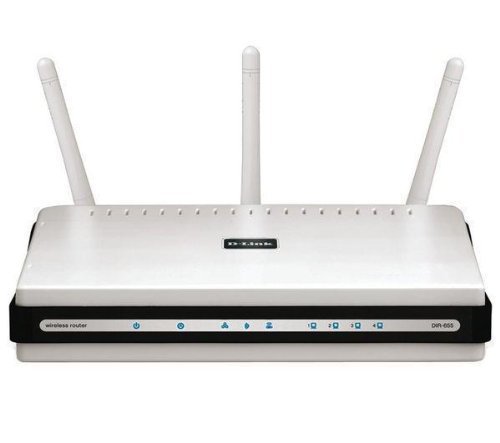Best D-link Routers For Long Range need?
With origins in Taiwan, this multinational company produces networking equipment for home and office use. It was founded in 1986 as Datex systems and its headquarters are in Taipei.
The company started as a vendor of network adapters but has since expanded to a developer, manufacturer, and designer of networking solutions for the business markets and the consumer.
It was named the leading networking company in the segment of small to medium businesses worldwide and with a market share of 21.9%.
In 2008, the company became the market leader in shipments of Wi-Fi products throughout the world. By then it had a market share of 33%.
The company was listed among the top 10 IT companies in the world by Business week.
D-LINK WIRELESS N 300 MBPS HOME CLOUD ROUTER (DIR-605L)
This router offers total compatibility and can work with any device that is Wi-Fi certified.
Therefore, you can monitor and control your wireless network despite the location.
It offers extended coverage, more speed, and high compatibility. With speeds of up to 300MBPS, you have peace of mind when video streaming, gaming or even surfing.
It also comes with four Ethernet ports that provide fast and reliable connections.
Additionally, you are protected against malicious attacks and threats due to the enhanced security features, which include an SPI firewall.
Design and ease of use
The DIR-605L is tiny and yet quite bulky at the same time.
That’s because while the router itself is small, fitting right on a large hand, its two non-detachable antennae, which stick up from the back, are oversize, making the whole package a little disproportionate.
Since all of the router’s ports (including four LAN ports and one WAN port), as well as the power port, is also on the same side as the antennae, you’ll find the back of the router quite crowded to work with.
On the front, the router has the usual array of tiny LEDs that show the status of the port on the back as well as the Internet and wireless connections.
On one side, there’s a WPS button for quickly hooking up clients using Wi-Fi Protected Setup.
The router comes with four rubber feet to keep it steady on a surface.
Since the router is very light, it’s a little hard for it to stay put, especially when there are multiple cables connected to it. The DIR-605L is not wall-mountable.
The DIR-605L doesn’t come with setup software, but it’s very easy to get it up and running anyway.
All you have to do is plug it in the power, connect the router to an internet source, such as a broadband modem, via its WAN port, and connect a computer to one of its WAN port.
After that, from the connected computer, point a browser, such as Firefox, to its default IP address, which is 192.168.0.1 and you’ll be greeted with its Easy Setup page.
Here you can change the router’s wireless network, set the encryption key and so on.
You can also use this page to create a mydlink account and associate the router with it.
If you want to access other features of the router, click on the Manual Setup button at the bottom of the page and you’ll find the common Web interface, similar to that of other D-link routers.
D-Link’s mydlink portal is a free service that allows users to manage D-Link’s Webcam. Starting with the DIR-605L, this portal is now also used to manage supported routers.
Once you have associated the router with a mydlink account, the router now becomes a cloud-based router.
2.4GHZ WIRELESS-N PERFORMANCE(IN MEGABITS PER SECOND)(Longer bars indicate better performance
Service and support
D-Link backs the D-Link DIR-605L Cloud Router with a one-year warranty, which is short but standard for most home routers.
At the company’s Web site, you will find a wealth of support information including downloads, FAQs, and a searchable knowledge base. You can also seek help through the company’s toll-free technical support phone line, which is available 24-7.
Conclusions
Affordable, reliable and simple, the D-Link DIR-605L Cloud Router makes a very good router for a simple home network.
Its cloud-based feature will also be the icing on the cake, a pleasant surprise for those who want to effectively monitor and manage their home network when on the go.
| [wp-svg-icons icon=”plus” wrap=”i”]Pros | [wp-svg-icons icon=”minus” wrap=”i”]Cons |
|
|
BOTTOM LINE
For those needing little more than a cheap router for a small home network with few devices, the DIR-605L will suffice. All others, steer clear.
D-LINK SYSTEMS AC1750 HIGH POWER GIGABIT ROUTER (DIR-859)
Over the years D-Link has been making many efficient networking products that are being used all around the world today, now they have mastered the art of making all sorts of routers and networking products that are made by their competition.
The D-Link Systems AC1750 (DIR-859) Router which is also known as the Dir-859 is one such highly polished product from D-Link, it is an economically priced mid-range router with plenty of useful features.
Lets take a deeper at all that this device has to offer and how it stand out from its competition.
Feature
The D-Link Systems AC1750 (DIR-859) Router is a one of kind router that looks quite regular but has some unique features that easy make this device stand out, its delivers an extreme signal coverage due to new signal amplifying technology. It avoid all interferences to deliver the fastest possible wireless speed within your home network, it can handle some heavy usage like multiplayer gaming, HD Streaming and even video chat and file transfers easily. It works well as a Dual band router working well on both 2.4 GHz and 5 GHz bands and manages to give extremely fast speeds and a very strong and stable wireless signal.
“This Router is loaded with new technology that stops any interference and delivers optimum speed to all devices, the external antennas helps in providing a stable connection at all ranges”
- Non-Detachable Antennas: The D-Link Systems AC1750 (DIR-859) Router has three non-detachable antennas, with the help of these the device transmits a consistent signal all across its range.
- Ethernet Ports: The Dir-859 comes with four on-board gigabit LAN ports for ultimate high speed wired connections, it also has one WAN port for internet input like in broadband routers.
- WPS Compatibility: This router also has a Wi-Fi Protected Setup button which is an easy way for users to connect to the router without entering the encryption key. When the button is pressed it opens up a 2 minute time windows where other WPS enabled device can connect to the network without going through the authentication process using the encryption key.
- Build and Design: The D-Link Systems AC1750 (DIR-859) Router is made with high quality plastic to ensure durable build quality, it is available only in glossy black color and looks quite elegant with plain and mesh textures. The design is similar to many variants of D-link routers but this one packs some unique features and new cutting edge technology.
- Speed and Range: The AC1750 DIR-859 was tested at close range where it gave an output of 40 Mbps when the device was 100 feet away from the router, later when the connection was test at 200 feet away the router still managed to give 37 Mbps because of its Extreme Coverage feature. This is quite impressive for a router in this price range, and it proved to be quite durable when tested to run for 48 hours in a stress test.
Technical Specification
| Brand | D-Link |
|---|---|
| Connectivity | wireless |
| Data Transfer Rate | 1300 Mbps |
| Lan Ports | 4 |
| Standard | 802 11 AC |
| model number | DIR-859S |
| Operating System | Windows 8.1, Windows 8, Windows 7, or Mac OS X (v10.7), Windows 8.1, Windows 8, Windows 7, or Mac OS X (v10.7) |
| Weight | 11.2 ounces |
| Dimensions | 6.5 x 12.5 x 1.2 inches |
| Wireless Type | 802.11 A/C, 5.8 GHz Radio Frequency, 802.11 a/b/g/n |
D-LINK SYSTEMS AC1750 (DIR-859) BENEFITS
- Setup & Security: The router is very easy to install as it comes with a CD which has the D-Link setup wizard which manually walks you through the whole installation process, once registered it will prompt the user to setup and SSID and a passphrase. It is loaded with the dual active firewall feature which is a new technology that protect the user’s privacy.
- Warranty & Support: D-Link has a limited warranty period of 1 year for the parts and 1 year for the labor and fitting, it except return within 45 days of the purchase and offer replacement within 1 year. They also provide customer support on their tool free support phone, or users can even go through their website to register their queries.
| [wp-svg-icons icon=”plus” wrap=”i”]Pros | [wp-svg-icons icon=”minus” wrap=”i”]Cons |
|
|
If you are looking of maximum performance when streaming HD media and gaming, then this router is one of the best.
It also allows you to monitor, connect, and control your network through the most advanced wireless technology.
With advanced AC SmartBeam, this router provides a huge increase in terms of wireless performance.
It also ensures efficient distribution of bandwidth through the Advanced Quality Of Service.
This means that your Ethernet and Wi-Fi speeds are superfast for all your home and office needs.
It is able to handle large bandwidth because of the increasing demands of today.
It has a high-powered amplifier and three external antennas that are high-gain to give you a stronger signal and wider range.
| [wp-svg-icons icon=”plus” wrap=”i”]Pros | [wp-svg-icons icon=”minus” wrap=”i”]Cons |
| User-friendly setup and management. Revamped, well-designed UI. Very good performance in 802.11n and legacy wireless modes. Excellent USB drive-sharing and remote-access capabilities. | Average to slightly below average 802.11ac wireless throughput. Did not sustain wireless throughput distance on the 2.4GHz band in tests. Confusing scheduling setup. |
Specs and Design
The router supports up to a theoretical 600Mbps at the 2.4GHz band, and up to 1,300Mbps at the 5GHz band for a total of 1900Mbps combined throughput (hence the “1900” in the name).
Inside, there’s a dual-core processor, which delivers peppy performance when navigating the interface or accessing a connected USB drive for NAS functionality. It has a lone USB 2.0 port, as well as a single USB 3.0 port.
On the back panel is a Gigabit WAN port along with four Gigabit LAN ports.
Today’s consumer wireless routers are increasingly simple to set up, and the DIR-880L is no exception.
The new interface looks sparse when compared with D-Link’s cluttered old UI.
On this screen is a top-level menu with the Settings, Features, and Management options.
The DIR-880L performed very well in all wireless modes except for 802.11ac, where it was average to below-average.
In 2.4GHz, the DIR-880L registered the second highest throughput we’ve seen, averaging 93.75Mbps (the TP-Link Archer C7 AC1750$107.28 at unbeatablesaleclocked the highest among 802.11ac routers in 2.4GHz mode with 99.75Mbps).
In 802.11n mode at the 5GHz band, the DIR-880L averaged 148.2Mbps, which placed it among the top ten fastest routers. That’s not that far behind our top performer in this mode, the Asus RT-AC68U $141.99 at Amazon, which averaged 185Mbps.
It’s in 802.11ac mode that D-Link’s router did not fare very well. It did better using my laptop’s 802.11n 3×3 wireless adapter rather than D-Link’s own Wireless AC1200 Dual Band USB Adapter (DWA-182). The DWA-182 is only a 2×2 adapter, so it can’t leverage the speed of a 3×3 router like the DIR-880L.
In 802.11ac mode the DIR-880L averaged about 144Mbps (and barely averaged 120Mbps with the D-Link adapter). This is significantly less throughput than I’ve seen from other 802.11ac routers, such as the Asus RT-AC68U, which hit 290.5Mbps.
The DIR-880L performed well at the 2.4GHz band, but it also dropped throughput by 21 percent when I moved the wireless client from 5 feet to 30 feet away. That surprised me, because D-Link’s Amplifi Cloud Router 5700 sustained the 2.4GHz band throughput; in fact, I actually saw a 5 percent throughput increase when I moved the wireless client from 5 to 30 feet.
2.4GHz Signal Drop or Gain, Moving From 5 to 30 Feet
5GHz 802.11n Signal Drop or Gain, Moving From 5 to 30 Feet
5GHz 802.11ac Signal Drop or Gain, Moving From 5 to 30 Feet
The router was more effective at sustaining throughput at the less-crowded 5GHz band, only dropping throughput by 3 percent in 802.11n and 802.11ac mode.
Only OK at AC
If you are dead-set on a top-performing 802.11ac router, the DIR-880L will disappoint you. In other wireless modes, however, it’s a very good performer. The new UI is a bonus, as is easy setup, capable remote access, and sharing. If you’re looking for a 802.11ac speed demon, check out the Asus RT-AC68U Dual-band Wireless-AC1900 Gigabit Router.
D-LINK AC3200 ULTRA TRI-BAND ROUTER (DIR-890L/R)TOP PICK
The model name for this particular router is DIR-890L/R and it’s only available in one color–candy apple red.
It measures a staggering 15” across by 9” deep and 5” tall and thankfully, despite its gargantuan size, it’s actually lighter than it looks. It sports six non-removable antennae
Since it’s an AC3200 router, it supports up to 3,200Mb/s of bandwidth across all three of its bands, though you’d never actually see those numbers in the real world.
The breakdown is as follows: 600Mb/s on the 2.4GHz band for “N” devices, and then two 1,300Mb/s 5GHz networks for AC devices.
Add it all up and you get 3,200, so despite companies making it sound like a router such as this is “faster” than an AC1900 router, in the real world it isn’t faster, it just has an extra network available but speeds are the same.
Since this is a router that’s been on the market for a while, it’s a pretty straightforward AC model, and is lacking the features that arrived recently in the “Wave 2” devices, including MU-MIMO.
This is technology that allows the router to serve multiple clients simultaneously, though the catch is those clients need MU-MIMO wireless adapters, which aren’t commonplace just yet.
Still, it offers beamforming, which allows the router to figure out where devices are located and concentrate its streams toward them. It also features a cool technology called Smart Connect, which allows all three networks to exist under one SSID, or network name, thus simplifying the connection process.
However, one potential downside of its design is its sheer size: the DIR-890L’s footprint is a huge 38cm x 23cm. Those aerials also mean it stands at 10.9cm tall. Mounting it vertically isn’t an option, unless you attach it to a wall; the screw holes for doing so are on its base. The power brick is just that – a hefty brick.
Those generous proportions should allow for plenty of airflow though, to keep the internal hardware cool. Plus, it provides ample space to fit in all the connectivity options.
Round the rear of the device are four gigabit Ethernet ports for connecting your PCs or other networking hardware. Alongside is a fifth Ethernet socket that attaches to your modem. There are also USB 2.0 and USB 3.0 ports for sharing storage devices or printers.
Wireless Performance
To test how the DIR-890L/R performs, I set up a server/client scenario with Netperf and two Windows 10 PCs, then measured the speed of the TCP connection between them. I measured at both 15 feet with line of sight, and at 30 feet with two walls between the computers. I ran the TCP test at least three times to make sure my results were consistent, and if they weren’t, I re-tested until they were, trying at different times of the day until I was satisfied. Though everyone’s environment is different, and you wouldn’t be able to exactly replicate my results, they are a good way to get a ballpark estimate of how the router performs. I also performed a “real world” 2GB file transfer test at 30 feet as well.
PERFORMANCE
Testing such multi-band AC routers has become increasingly tough, since few client devices support the maximum throughput.
This is made even more difficult due to the presence of two bands on the DIR-890L – which, theoretically, should demand two devices to be straining it at the same time (or arguably three, with one on the 2.4GHz band). However, then you’d be maxing out the Ethernet connections that are feeding data into the router, causing yet another issue.
All in all, it certainly isn’t a trivial task to set up a real-world, quantifiable testing scenario.
As such, we’ve stuck to our standard router test, which investigates the router’s effectiveness at a variety of ranges over both the 2.4GHz and 5GHz bands.
A PC is set up with the Asus PCE-AC68 Wi-Fi card and placed adjacent to the router, then at 5m away with two brick walls in between, and finally at a distance of 10m away with a further wall in between. Maximum throughput is measured using a real-world file transfer at each of these distances.
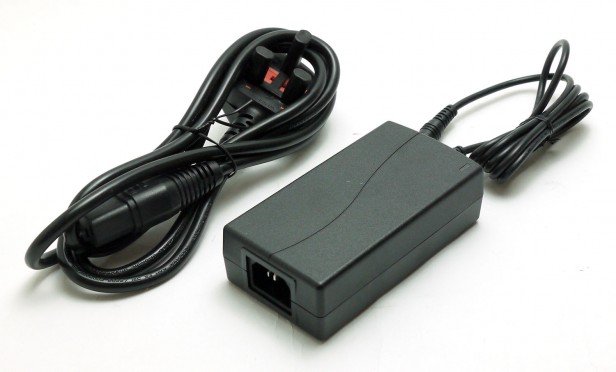
The router was installed for a week to test its general reliability, to ensure the Wi-Fi signal remains consistent and that the unit doesn’t crash or loose connection. This reliability test is particularly important, since we’ve discovered that some routers – such as the Netgear Nighthawk range, for example – are fast in test conditions but are unreliable in day-to-day use.
Thankfully, the D-Link DIR-890L passed with flying colours on the latter point, proving rock-solid throughout.
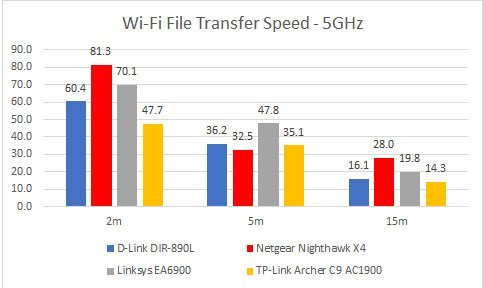
For speed, the DIR-890L was less impressive. While it largely delivered the sort of speeds and range you’d expect of a high-end router, it couldn’t match the best on either account.
Using the 5GHz band – either of them, since they delivered the same speeds – it delivered 60.4MB/sec in our close-range test. This is some way behind the 70.1MB/sec of the Linksys AC1900 and 81.34MB/sec of the Netgear Nighthawk X4 R7500.
This trend continued throughout our tests, with the DIR-890L delivering 36.2MB/sec at 5m, which compares to 47.8MB/sec for the Linksys. It did actually beat the Netgear here, which achieved only 32.5MB/sec.
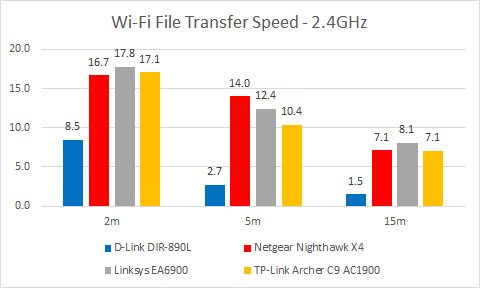
At 15m, though, the D-Link trailed both again, hitting 16.1MB/sec at its peak, compared to 28.0MB/sec for the Netgear and 19.8MB/sec for the Linksys. It only beat the TP-Link Archer C9 at 5GHz consistently.
However, at 2.4GHz it came last, trailing all our other AC1900+ routers by huge margins. What’s more, there was often a noticeable delay before a file transfer started when using both the 2.4GHz and 5GHz bands at long range. Sometimes it took as long as 20 seconds before the transfer began.
There’s a degree of environmental variance here – the D-Link was tested on a day when it was pouring with rain – but this still shouldn’t account for such a huge drop.
Thankfully, the speeds are still perfectly usable for most day-to-day tasks. Moreover, when it comes to file-transfer speeds to attached USB devices, the DIR-890L does very well indeed, hitting 35.5MB/sec write and 65.2MB/sec read.
| [wp-svg-icons icon=”plus” wrap=”i”]Pros | [wp-svg-icons icon=”minus” wrap=”i”]Cons |
|
|
Conclusion
The D-Link DIR-890 is without doubt a good high-end Wi-Fi router, having three things going for it: a great design, fast speeds (both Wi-Fi at close range and storage) and strong signal stability. Unfortunately, its range falls short, and the lack of configuration settings and features are disappointing. On top of that, it’s just too expensive.
With that in mind, I’d recommend it only for non-tech savvy users who have multiple 5GHz clients, need to do lots of heavy tasks via Wi-Fi, and live in a relatively small home. If you fit this category and don’t mind spending the dough, you’ll be happy with it.
D-LINK WIRELESS N300 MBPS EXTREME-N ROUTER (DIR-655)
Setup and design
The DIR-655 looks like a typical wireless router with a square shape and three detachable antennas sticking up from its back, cluttering the network ports.
The router’s ports include four Gigabit LAN ports (for wired clients), one WAN port (to be hooked to an Internet source, such as a broadband router), and a USB port. This USB port can be used to host a USB device or to support Windows Connect Now (WCN). WCN is an old but handy technology that allows you to transfer the router’s encryption key from the router to a Windows computer using a USB key, sparing you from having to remember the encryption key.
On the side, the router has a Wi-Fi Protected Setup button, which is another convenient way to let wireless clients enter the encrypted wireless network.
Press this button and you open a 2-minute time window in which other WPS-enabled devices can join the network without you having to enter the encryption key manually.
On the front, like most routers, the DIR-655 has an array of blue LED lights showing the status of the router, the LAN ports, the wireless network, the USB port, and the connection to the Internet.
We didn’t experience any problems setting up the DIR-655.
The router comes with a CD that contains the D-Link Router Quick Setup desktop software.
Following the wizard, we were able to get everything up and running, including connecting to the Internet and other wireless clients; we were also able to set up an SSID for each frequency. Alternatively, you can use the Web-based interface, which is well-thought-out, responsive, and more comprehensive than the desktop application.
Like most D-Link routers, the DIR-655 is wall-mountable and also comes with a detachable base to enable it to work in the vertical position.
Features
D-Link regularly releases new firmware for its routers, which, apart from fixing bugs, sometimes dramatically changes the feature set of the router.
We tested the DIR-655 with its latest firmware, version 1.34NA. Initially, its USB port was designed just to host a USB printer, but starting with firmware version 1.21, the router has a new feature called SharePort. This enables the router’s USB port to work as a networked USB port.
SharePort comes with a software application called SharePort Network USB (SNU) that you’ll need to install on your network computers.
The software allows the computer to recognize a USB device plugged into the router as if it were plugged directly into the computer’s USB port. For this reason, unlike other USB-equipped routers that support only printers and external hard drives, SharePort allows the DIR-655 to share virtually any USB device over your network.
SharePort does have a big drawback, however. By making the router’s USB port work the same way as a computer’s, SharePort makes it so only one PC can access a USB device plugged into the router at a time.
So, if one person is using a printer that’s plugged into the router, others won’t have access to it until it is released using the SharePort Network USB software.
This makes it a little less appealing than the old print-serving feature, where the printer could be accessed by multiple computers at a time.
We tried the SharePort USB port with multiple devices, including printers and external hard drives, and it worked as intended.
We found that you can still share the attached USB device with multiple computers if you just share it from the one computer that has control over it, the same way you would share a folder or a computer on that computer.
This seems to be a workaround to spare you from having to install SNU on multiple computers.
However, this also means the host computer has to be on for the device to be available to the rest of the network.
This router delivers higher transfer speeds and wider network coverage, compared to devices in the same category.
This means that your office or home will have wider network coverage with stable speeds. If you have several devices, you can also connect through the Ethernet ports that produce reliable and incredible speeds.
It is an ideal router for streaming multiple applications and HD video simultaneously.
It has been designed with intelligent QoS technology for prioritizing wireless and wired internet traffic.
This enhances phone calling and gaming experience.
It has a firewall protection that is dual active to protect you against malicious attacks when you are connected to the internet.
Other than that, the DIR-655 offers numerous network features found in other Wireless-N routers from D-Link and a very well-organized Web interface.
You can set up manual port forwarding–where you map information coming to certain ports to a certain computer in the network–or use the router’s preset settings for different applications and services such as instant-messaging software, BitTorrent, IP phone software, virtual servers, and so on.
It offers a comprehensive set of parental control tools including Network Filter, Access Control, Web Site Filter, and Inbound Control.
These tools allow you to control the network and limit access to the Internet according to specific criteria;
for example, you can prevent a particular computer from accessing adult Web sites, or you can only allow it to run IM programs during certain periods of time.
The router also has an easily customizable QoS feature that helps you prioritize your Internet and network traffic for different services.
Like other new high-end routers from D-Link, the DIR-655 comes with an interesting and useful feature called Guest Zone, which lets you create a separate wireless network to be used by guests or the public. Any wireless client connected to these guest networks gets access to the Internet but not your local LAN resources.
Performance
We tested and stacked the DIR-655 against recent routers and it fared really well. Though not the fastest, it is among the top five in terms of throughput performance.
In a close-range throughput test, the DIR-655 scored 50.6Mbps, significantly faster than the Apple Time Capsule,
which scored 32.2MBps, but noticeably slower than the TrendNet TEW-691GR’s score of 70.7Mbps. At this speed, the D-Link can finish transmitting 500MB of data in less than 80 seconds.
In the long-range test,
where the router was put 100 feet away from the client, the D-Link’s throughput reduced to 38.4Mbps. In the mixed-mode test, where the router was set to work with both N and pre-N clients, it registered 41.4Mbps.
The router offered decent range and was able to hold a steady connection from up to 270 feet away in our testing facility.
Note, however, that 100 feet or less is the optimal distance if you want to stream content, especially hi-def movies, over the wireless connection.
The DIR-655 impressed us with its signal stability. It passed our 48-hour stress test without a hitch.
During this time the router was set to transfer a large amount of data back and forth between multiple clients. It didn’t disconnect once.
| [wp-svg-icons icon=”plus” wrap=”i”]Pros | [wp-svg-icons icon=”minus” wrap=”i”]Cons |
| Fast (thanks to Gigabit Ethernet LAN ports) and feature-rich. |
|
BOTTOM LINE
This fast wireless router comes with Gigabit LAN ports and has many features, including QoS monitoring, but the complex interface may intimidate some.
D-Link marketing channels are indirect, operating through distributors, retailers, and resellers.
Its products are targeted towards the communications and networking market.
These include surveillance network cameras, switches, firewalls, and business wireless.
For the consumer market, the company produces broadband devices, wireless devices, and digital home devices, such as storage media, media players, and surveillance cameras.
It was the first wireless and wired company to produce networking devices using green technology.
This technology was applied to the wireless routers and unmanaged switches. It is a power saving technology that reduces power consumption by switching off idle ports.

Hi! I am Martha D. I have over 20 years of experience in troubleshooting technical problems. I created Technipages so I could share my adventures in troubleshooting, and
I hope readers find the solutions posted on this site as useful as I do


